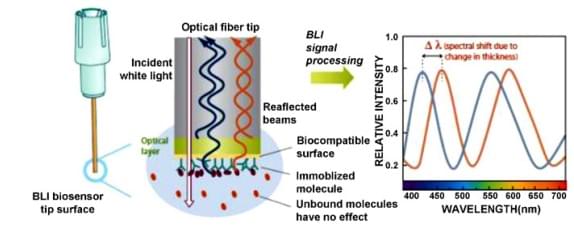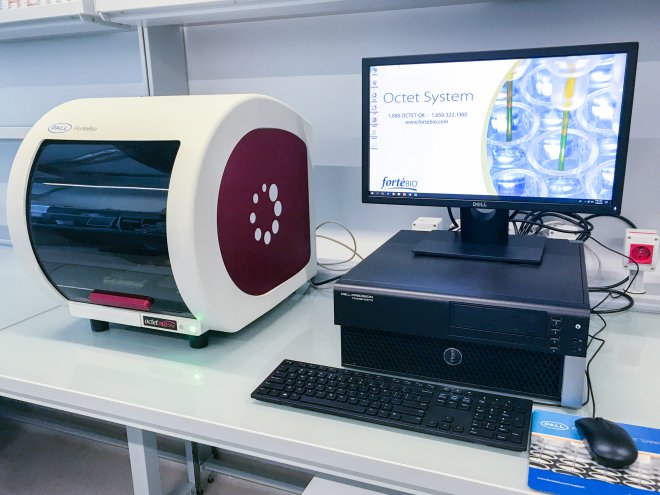BioLayer Interferometry
PRESENTATION
The SPR/BLI platform provides a PALL/FortéBio instrument for the characterization of biomolecular interactions by detection by Biolayer Interferometry (BLI).
BLI is an optical technique that measures variations in optical thickness at the surface of a biosensor through interference created by the reflection of a light beam on the surface of the biosensor and on the surface of the biomolecular layer. As they are dependent on the size of the constituents on the surface, this technique allows the detection in real time and without marking of biological molecules.

With the OctetRED96e, the technology is applied to the study of partner interactions and the determination of kinetic constants of associations and dissociations (kon, koff), affinity constant (KD) or the quantification of biological molecules (concentration).
The method is based on a biosensor on which a first molecule (ligand) is captured, and the binding of the second partner (analyte) is measured on the surface of the biosensor. The response is measured in real time (sensorgram).
It applies to the characterization of molecular interactions involving small molecules and all classes of biological macromolecules (proteins, polysaccharides, lipids and nucleic acids).

ACCESS, LOCATION, BOOKING, RATES AND CONTACTS
Access
The BLI platform is open to :
- Academics according to modalities to be defined (access to the service/autonomous or collaboration) according to the involvement of the platform staff.
- Industrial in the form of a service on quotation.
Tariffs
The access tariffs are available for consultation here.
The rates are exclusive of tax (excluding VAT) and per day of use. They can be reviewed once a year.
PRICE TABLE AVAILABLE SOON
The prices include access the OctetRED96e instruments of the platform and to the equipment and consumables described in the paragraph "The platform provides". They do not include specific consumables that will be provided by the user.
Any additional consumables provided by the platform and used will be charged in addition to the price of access to the instrument.
On request, a quotation can be provided.
Location
The SPR/BLI platform is located on the EPN campus in Grenoble, in the IBS building, room 426 : http://www.isbg.fr/contact/article/access
External users must request authorization to access the EPN campus. Contact the platform staff before your visit.
External users can request accommodation at EPN campus Guest house (at their own expense). Contact the platform staff before your visit.
Use of the platform
New users
Each new user must contact the platform staff before any experimentation or instrument reservation.
A preliminary meeting is mandatory for :
- Define the terms of use of the platform : collaboration or autonomous access.
- Discuss the experimental conditions and define the best strategy for carrying out the study.
- Schedule training and first use of the instrument.
Each user must agree to comply with the GENERAL CONDITIONS AND OPERATING INSTRUCTIONS.
Referred users
Trained and registered users can book directly after checking the booking schedule.
Availability and reservation
Booking
Each user must reserve their use of the OctetRED96 by filling in the RESERVATION FORM.
Availability
The Availability of the OctetRED96e is available here
Contacts
Address
SPR/BLI platform
Institute of Structural Biology - UMR 5075 (CNRS-CEA-UJF)
71 Avenue des Martyrs
CS 10090
38044 Grenoble cedex 9
FRANCE
E-mail : ibs-plateforme-spr.contact ibs.fr
Scientific Manager
Jean-Baptiste Reiser
E-mail : jean-baptiste.reiser ibs.fr
Telephone : +33 (0)4 57 42 85 49
GETTING STARTED GUIDE
A usage guide for the OctetRED96e can be downloaded : GETTING STARTED GUIDE.
WHAT TO BRING FOR YOUR EXPERIMENTS
You need
- Running buffer(s).
- Ligand samples at the highest concentrations (to be diluted in immobilization buffers).
- Analytes samples at the highest concentrations (to be diluted in running buffers).
- Regeneration buffers if known.
- Biosensors.
- Pipettes and tips (preferably checked and calibrated).
- Necessary plastic tubes (Falcon, Eppendorf type tubes).
- Any previous and relevant data and/or protocols.
Ordering consumables and kits
Users must provide consumables specific to their experiments.
Consumables must be ordered from Fotébio/Molecular Devices (www.fortebio.com).
No other biosensors will be accepted.
The plateform makes available biosensors (type A2RG - amine coupling or SA - Streptavidine). Any used biosensor will be charged in addition to the price of access to the instrument.
WHAT THE PLATFORM PROVIDES
The BLI platform provides basic and common supplies for experiments on the OctetRED96e :
- the instrument.
- 4°C refrigerator and -20°C -20°C -20°C freezer for sample storage.
- Vortex and benchtop centrifuge.
- P20/Tween-20 (added to your experiment buffers).
- BSA (added to your experiment buffers).
- Immobilization kits for amine coupling methods.
- Regeneration scouting kit.
- 96-wells plate for OctetRED96e.
- External users who cannot bring laboratory supplies can borrow supplies from our laboratory (pipettes, tips, plastic and glass items).
- If necessary, a UV/visible nanodrop spectrophotometer is available in our laboratory (room 520).
- Filtered water solutions, instrument maintenance.
HOW MUCH TIME DO I NEED ?
The time required to fully characterize your interaction depends on your biological system, the strategy used, the time needed to optimize your experiences and the difficulties you may encounter...... It can vary from a few days to a few weeks.....
Here are some estimates of the time required for traditional methods :
- Starting sequence : 5 to 10 min.
- Immobilisation Scouting : 30 to 60 min per ligand sample.
- Immobilization by amine coupling : 45 to 60 min per sample.
- Secondary capture : 20 to 30 min per sample.
- Pilot analyses : ½ daily to several days depending on the number of sample injections at different concentrations, testing of several contact and dissociation times, several flow rates and regeneration conditions.
- MCK/Steady State : 30 to 1 hour or more depending on kinetics and concentrations.
- Stop sequence : 5 to 10 min.
COMPUTING
The platform provides computers dedicated to the control of each instrument, the implementation of experiments, data acquisition and recording and data analysis,
The platform provides an additional computer with free access for data analysis and processing,
All computers are equipped with regularly updated software necessary for data monitoring and analysis,
ACKNOWLEDGEMENTS, PUBLICATIONS AND VALORIZATION
Collaborations
Collaborative projects require that platform staff co-author publications in peer-reviewed journals and other communications in which SPR or BLI data appear and in accordance with the terms previously discussed.
Service - made available
Users undertake to mention the platform and its staff in all publications or communications in which SPR or BLI data appear by mentioning the following sentence : "This work used the platforms of the Grenoble Instruct-ERIC center (ISBG ; UAR 3518 CNRS-CEA-UGA-EMBL) within the Grenoble Partnership for Structural Biology (PSB), supported by FRISBI (ANR-10-INBS-0005-02) and GRAL, financed within the University Grenoble Alpes graduate school (Ecoles Universitaires de Recherche) CBH-EUR-GS (ANR-17-EURE-0003). Authors acknowledge the SPR/BLI platform scientific responsible, Jean-Baptiste REISER Ph.D., for its help and assistance."
Quality
As part of its structuring and continuous improvement, the SPR technical platform is committed to the implementation of a quality approach that led to ISO 9001:2015 certification since June 2011.

REFERENCES
Generalities on BLI technology
|



